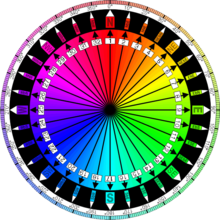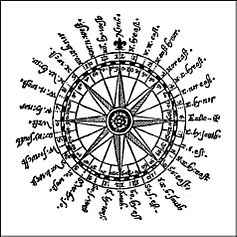Points of the compass

Boxing the compass is the action of naming all thirty-two clockwise points of the compass in order. Such names are formed by the initials of the cardinal directions and their intermediate ordinal directions, and are very handy to refer to a heading (or course or azimuth) in a general or colloquial fashion, without having to resort to computing or recalling degrees. For most applications, the minor points have been superseded by degrees measured clockwise from North.
Compass points
| # | Compass point | Abbr. | Traditional wind point | Lowest | Middle | Highest |
|---|---|---|---|---|---|---|
| 1 | North | N | Tramontana | 0.00° | 5.62° | |
| 2 | North by east | NbE | Qto Tramontana verso Greco | 5.63° | 11.25° | 16.87° |
| 3 | North-northeast | NNE | Greco-Tramontana | 16.88° | 22.50° | 28.12° |
| 4 | Northeast by north | NEbN | Qto Greco verso Tramontana | 28.13° | 33.75° | 39.37° |
| 5 | Northeast | NE | Greco | 39.38° | 45.00° | 50.62° |
| 6 | Northeast by east | NEbE | Qto Greco verso Levante | 50.63° | 56.25° | 61.87° |
| 7 | East-northeast | ENE | Greco-Levante | 61.88° | 67.50° | 73.12° |
| 8 | East by north | EbN | Qto Levante verso Greco | 73.13° | 78.75° | 84.37° |
| 9 | East | E | Levante | 84.38° | 90.00° | 95.62° |
| 10 | East by south | EbS | Qto Levante verso Scirocco | 95.63° | 101.25° | 106.87° |
| 11 | East-southeast | ESE | Levante-Scirocco | 106.88° | 112.50° | 118.12° |
| 12 | Southeast by east | SEbE | Qto Scirocco verso Levante | 118.13° | 123.75° | 129.37° |
| 13 | Southeast | SE | Scirocco | 129.38° | 135.00° | 140.62° |
| 14 | Southeast by south | SEbS | Qto Scirocco verso Ostro | 140.63° | 146.25° | 151.87° |
| 15 | South-southeast | SSE | Ostro-Scirocco | 151.88° | 157.50° | 163.12° |
| 16 | South by east | SbE | Qto Ostro verso Scirocco | 163.13° | 168.75° | 174.37° |
| 17 | South | S | Ostro | 174.38° | 180.00° | 185.62° |
| 18 | South by west | SbW | Qto Ostro verso Libeccio | 185.63° | 191.25° | 196.87° |
| 19 | South-southwest | SSW | Ostro-Libeccio | 196.88° | 202.50° | 208.12° |
| 20 | Southwest by south | SWbS | Qto Libeccio verso Ostro | 208.13° | 213.75° | 219.37° |
| 21 | Southwest | SW | Libeccio | 219.38° | 225.00° | 230.62° |
| 22 | Southwest by west | SWbW | Qto Libeccio verso Ponente | 230.63° | 236.25° | 241.87° |
| 23 | West-southwest | WSW | Ponente-Libeccio | 241.88° | 247.50° | 253.12° |
| 24 | West by south | WbS | Qto Ponente verso Libeccio | 253.13° | 258.75° | 264.37° |
| 25 | West | W | Ponente | 264.38° | 270.00° | 275.62° |
| 26 | West by north | WbN | Qto Ponente verso Maestro | 275.63° | 281.25° | 286.87° |
| 27 | West-northwest | WNW | Maestro-Ponente | 286.88° | 292.50° | 298.12° |
| 28 | Northwest by west | NWbW | Qto Maestro verso Ponente | 298.13° | 303.75° | 309.37° |
| 29 | Northwest | NW | Maestro | 309.38° | 315.00° | 320.62° |
| 30 | Northwest by north | NWbN | Qto Maestro verso Tramontana | 320.63° | 326.25° | 331.87° |
| 31 | North-northwest | NNW | Maestro-Tramontana | 331.88° | 337.50° | 343.12° |
| 32 | North by west | NbW | Qto Tramontana verso Maestro | 343.13° | 348.75° | 354.37° |
| 1 | North | N | Tramontana | 354.38° | 360.00° |
Compass point names


The names of the 32-wind compass rose follow these rules:
- The cardinal directions are North (N), East (E), South (S), West (W), at 90° angles on the compass rose.
- The ordinal directions are Northeast (NE), Southeast (SE), Southwest (SW) and Northwest (NW), formed by bisecting the angle of the cardinal winds. The name is merely a combination of the cardinals it bisects.
- The eight principal winds (or main winds) are the cardinals and ordinals considered thogether, that is N, NE, E, SE, S, SW, W, NW. Each principal wind is 45° from its neighbor. The principal winds form the basic eight-wind compass rose.
- The eight half-winds are the points obtained by bisecting the angles between the principal winds. The half-winds are North-northeast (NNE), East-northeast (ENE), East-southeast (ESE), South-southeast (SSE), South-southwest (SSW), West-southwest (WSW), West-northwest (WNW) and North-northwest (NNW). Notice that the name is constructed simply by combining the names of the principal winds to either side, with the cardinal wind coming first, the ordinal wind second. The eight principal winds and the eight half-winds together yield a 16-wind compass rose, with each compass point at a 221⁄2° angle from the next.
- The sixteen quarter winds are the direction points obtained by bisecting the angles between the points on a 16-wind compass rose. The sixteen quarter-winds are North by east (NbE), Northeast by north (NEbN), Northeast by east (NEbE), East by north (EbN) in the first quadrant, East by south (EbS), Southeast by east (SEbE), Southeast by south (SEbS), South by east (SbE) in the second quadrant, South by west (SbW), Southwest by south (SWbS), Southwest by west (SWbW), West by south (WbS) in the third quadrant, and finally West by north (WbN), Northwest by west (NWbW), Northwest by north (NWbN) and North by west (NbW) in the fourth quadrant.
The eight principal winds, eight half-winds and sixteen quarter winds together yield a 32-wind compass rose, with each compass direction point at 111⁄4° angle from the next.
The name of a quarter-wind is typically "X by Y", where X is a principal wind and Y is a cardinal wind. As a mnemonic device, it is useful to think of "X by Y" as a shortcut for the phrase "one quarter wind from X towards Y", where a "quarter" is 111⁄4°, X is the nearest principal wind, and Y the next (more distant) cardinal wind. So "Northeast by east" means "one quarter from NE towards E", "Southwest by south" means "one quarter from SW towards S". The title of the famous Alfred Hitchcock 1959 movie, North by Northwest, is actually not a direction point on the 32-wind compass, as one quarter away from North towards the direction of Northwest is expressed as "North by west", and not "North by northwest". If the author of the film 'title' (suggested as the head of the story department at MGM), meant one point from Northwest towards North, the correct term would be "Northwest by North".
Traditional names
The traditional compass rose of eight winds (and its 16-wind and 32-wind derivatives) was invented by seafarers in the Mediterranean Sea during the Middle Ages (the ancient Greco-Roman 12 Classical compass winds have little to do with them). The traditional mariner's wind names were expressed in Italian - or, more precisely, the Italianate Mediterranean lingua franca common among sailors in the 13th and 14th C., that was principally composed of Genoese (Ligurian), mixed with Venetian, Sicilian, Provençal, Catalan, Greek and Arabic terms from around the Mediterranean basin.

This Italianate patois was used to designate the names of the principal winds on the compass rose found in mariner compasses and portolan charts of the 14th and 15th C. The "traditional" names of the eight principal winds are:
- (N) - Tramontana
- (NE) - Greco (or Bora in some Venetian sources)
- (E) - Levante (sometimes Oriente)
- (SE) - Scirocco (or Exaloc in Catalan)
- (S) - Ostro (or Mezzogiorno in Venetian)
- (SW) - Libeccio (or Garbino, Eissalot in Provençal)
- (W) - Ponente (or Zephyrus in Greek)
- (NW) - Maestro (or Mistral in Provençal)
Local spelling variations are far more numerous than listed, e.g. Tramutana, Gregale, Grecho, Sirocco, Xaloc, Lebeg, Libezo, Leveche, Mezzodi, Migjorn, Magistro, Mestre, etc. Traditional compass roses will typically have the initials T, G, L, S, O, L, P, and M on the main points. Portolan charts also color-coded the compass winds: black for the eight principal winds, green for the eight half-winds and red for the sixteen quarter-winds.
In the English compass, all wind names are constructed on the basis of the cardinal four names (N, E, S, W). In the traditional compass, one needs to memorize eight basic names - one for each of the eight principal winds. While there are more names to memorize, the payoff is that the name construction rules for the 32-wind compass are more straightforward. The half-winds are just a combination of the two principal winds it bisects, with the shortest name usually coming first (e.g. NNE is "Greco-Tramontana", ENE is "Greco-Levante", SSE is "Ostro-Scirocco", etc.). The quarter winds are phrased "Quarto di X verso Y" (one quarter from X towards Y) or "X al Y" (X to Y) or "X per Y" (X by Y). There are no irregularities to trip over: the nearest principal wind always comes first, the more distant one second, e.g. North-by-east is "Quarto di Tramontana verso Greco", Northeast-by-north "Quarto di Greco verso Tramontana". The names are perfectly symmetric.
See also
|
|
External links
- Wind Rose (Archived) – discusses the origins of the names for compass directions.
